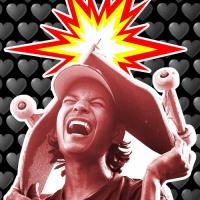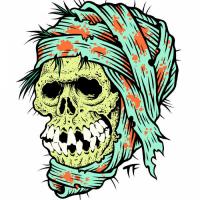James Callahan: A Bounty of Barf
8/01/2022
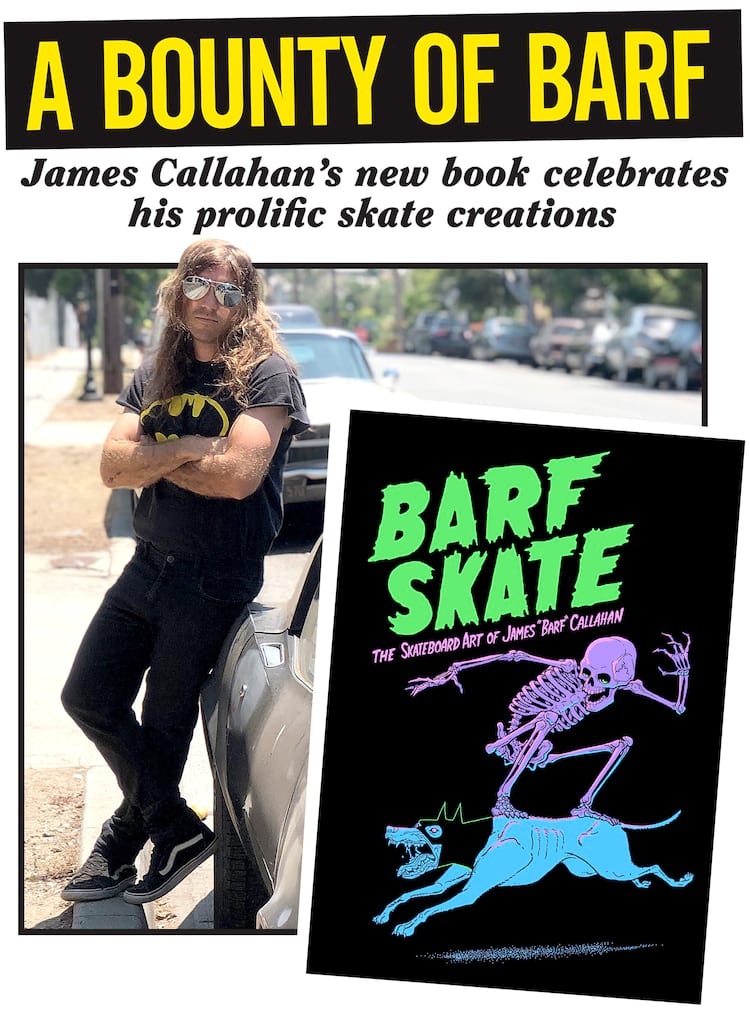
JAMES "BARF" CALLAHAN is one of the most prolific illustrators alive today. He recently published a coffee-table book, Barf Skate, which features only his skate-related art. If he had tried to include his entire portfolio, the book would be the size of a car. James is a long-time contributor to Thrasher and he created such gold as Ditch Diablo, Slam Demons, Comix, The Journey, and a dozen more articles. We caught up with the wizard himself and dove right into the brain of Barf.
Interview by Adam Creagan
What are your earliest memories of creating art?
It’d have to be drawing stick-figure comics on notebook paper with my brothers. They were usually colored-marker drawings of violent military assaults with jets and lasers and the protagonists invading elaborate bases full of booby traps. I think storytelling was an even earlier motivation than drawing itself.
What do you regard as some of the most classic skateboard graphics?
Brutal question. How do I pick a list among all things Phillips, VCJ, Pushead, Cliver, Pettibon, Natas and the other undisputed greats? I guess a favorite I’ll single out, if just for its unusualness, is the Daniel Clowes art for the Corey O’Brien Santa Cruz “Sweaty Devil/Mutant City” graphic. His comic book art was always mind blowing to me and very formative to my art tastes as a young buck.
It’s pretty evident that you can draw anything. Is there any artistic kryptonite that you personally feel that you don’t create very well—some particular subject matter or detail in which you’re not pleased with your own work?
Ha, thanks! I used to take pride in being able to draw anything that someone could come up with. I loved the challenge of trying to visualize an abstract concept, communicate ambiguities and draw the impossible. The problem with that, though, is that I’d sometimes get handed a sort of wack idea that I’d then have to figure out a way to make it look interesting. All that said, some things aren’t my strong suit. Portraits and likenesses can be a battle. I can do them, but it usually takes a few cracks, and even then might feel a bit stiff. Cars don’t come naturally for me either. I envy someone who can draw a real good-looking car, especially in motion.

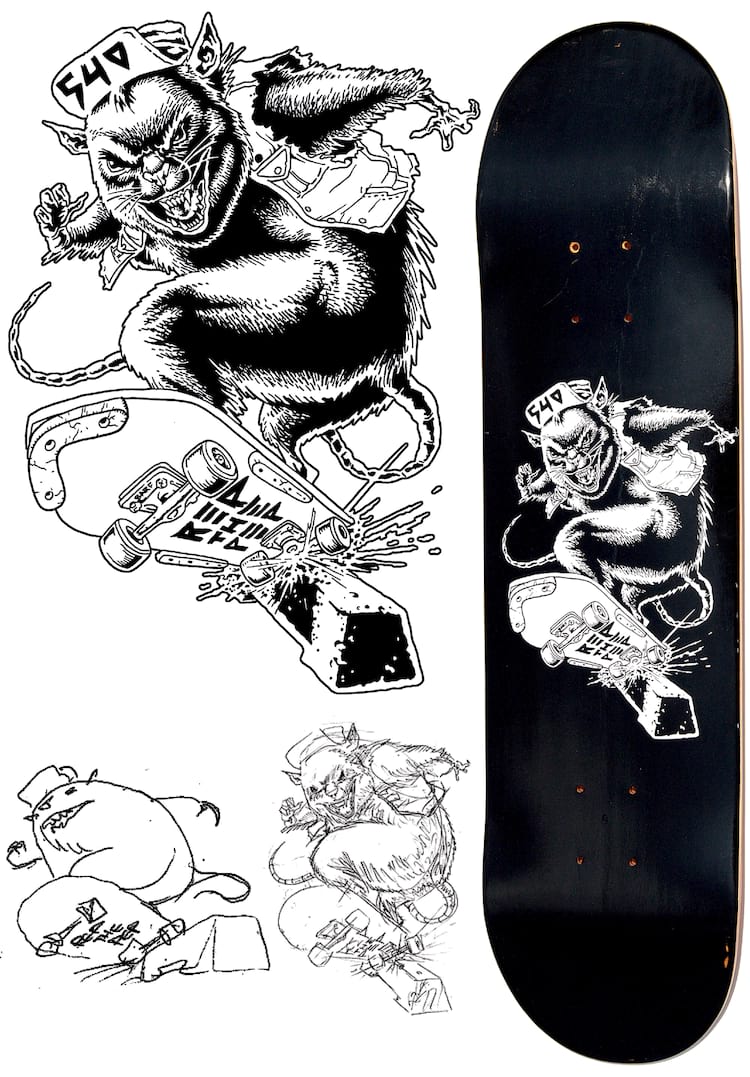

Interview by Adam Creagan
What are your earliest memories of creating art?
It’d have to be drawing stick-figure comics on notebook paper with my brothers. They were usually colored-marker drawings of violent military assaults with jets and lasers and the protagonists invading elaborate bases full of booby traps. I think storytelling was an even earlier motivation than drawing itself.
What do you regard as some of the most classic skateboard graphics?
Brutal question. How do I pick a list among all things Phillips, VCJ, Pushead, Cliver, Pettibon, Natas and the other undisputed greats? I guess a favorite I’ll single out, if just for its unusualness, is the Daniel Clowes art for the Corey O’Brien Santa Cruz “Sweaty Devil/Mutant City” graphic. His comic book art was always mind blowing to me and very formative to my art tastes as a young buck.
It’s pretty evident that you can draw anything. Is there any artistic kryptonite that you personally feel that you don’t create very well—some particular subject matter or detail in which you’re not pleased with your own work?
Ha, thanks! I used to take pride in being able to draw anything that someone could come up with. I loved the challenge of trying to visualize an abstract concept, communicate ambiguities and draw the impossible. The problem with that, though, is that I’d sometimes get handed a sort of wack idea that I’d then have to figure out a way to make it look interesting. All that said, some things aren’t my strong suit. Portraits and likenesses can be a battle. I can do them, but it usually takes a few cracks, and even then might feel a bit stiff. Cars don’t come naturally for me either. I envy someone who can draw a real good-looking car, especially in motion.




You had a gnarly arm injury that was almost a game changer for you. Can you describe that?
I was skating the Autumn Bowl in the early 2000s with my friend Pat late one Saturday night. My board shot out from beneath me. I fell back and tried to catch myself but had too much momentum. The impact forced a double compound fracture, snapping both bones in my forearm completely in half with the pieces puncturing the skin and going back in. After going to an emergency room in New York at 2 AM and witnessing gross incompetency and total chaos, I checked myself out and went home to Virginia. The doctors there were livid that I left the first hospital and warned me they may have to amputate. Fortunately, I was able to keep the hand after two plates and 13 screws were installed, although I do have permanent nerve damage with no feeling in a few fingers and my thumb. After that I swore I was done with skating forever. That lasted about six months. Since then I’ve skated infinitely more than I ever did before that injury. It made me realize what skating really meant to me.
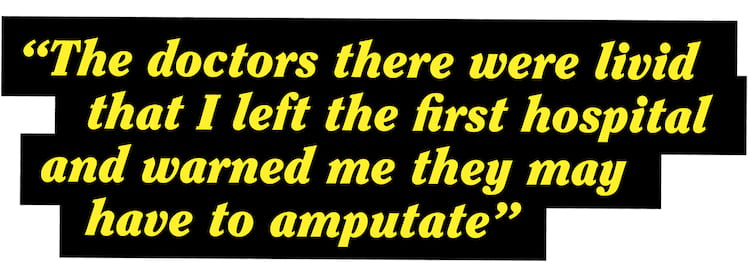
Born Ugly was one the best, most underrated skate zines I’ve ever seen. You guys killed it on that. What are your memories of that project?
Thank you. It’s good to hear that because it was a real labor of love for Mickael Broth and I. Making Born Ugly was tedious and taxing, but it really brought people together in ways that few other projects I’ve worked on ever have. Skaters who were strangers coalesced around DIY, art and fun. I’d say it was a crew, but it was so broad and big, that was like a whole new scene. A decade later, we’re all still good friends. The zine is a distant memory, but all these people are now like family and continue to create, build and skate together.

This book is focused exclusively on your skate-related art. What percentage of your total artistic output has been skate related?
It used to be far fewer, like less than a quarter of the work I was doing. Now it varies between half and most of the art I’m making. Some of that is just the way projects snowball. If you create something to the best of your ability, chances are that someone will see it and get an idea for something else they want you to make. Next thing you know, you’re working on half a dozen skate decks at once. The rest of the time I’m usually working on comics, so skate decks are a refreshing change.
What made you decide to lay out and publish this book on your own as opposed to looking for a book deal?
The creative autonomy was the deciding factor. The book was already going to consist of my artwork and my writing, so catching someone up to speed just to compromise with their ideas felt counterproductive. I knew all this material inside and out, and in many ways it’s my own personal story of being a freelance artist, so it seemed to only make sense that I use my individual vision to compose this collection. Additionally, the work is all owned by me, so the idea of muddying up the water on that ownership by partnering with a publisher was in no way appealing.
The formats of making a book are a bit rigid compared to the art you make with a pen. What was your experience like in terms of creating the book’s layout?
It was actually fun. I’ve got a bit of an obsessive side when it comes to organizing, so cataloging all this work and dividing it into subgroups scratched that itch. I had been envisioning this project for years and getting to put these pieces into place was very satisfying.
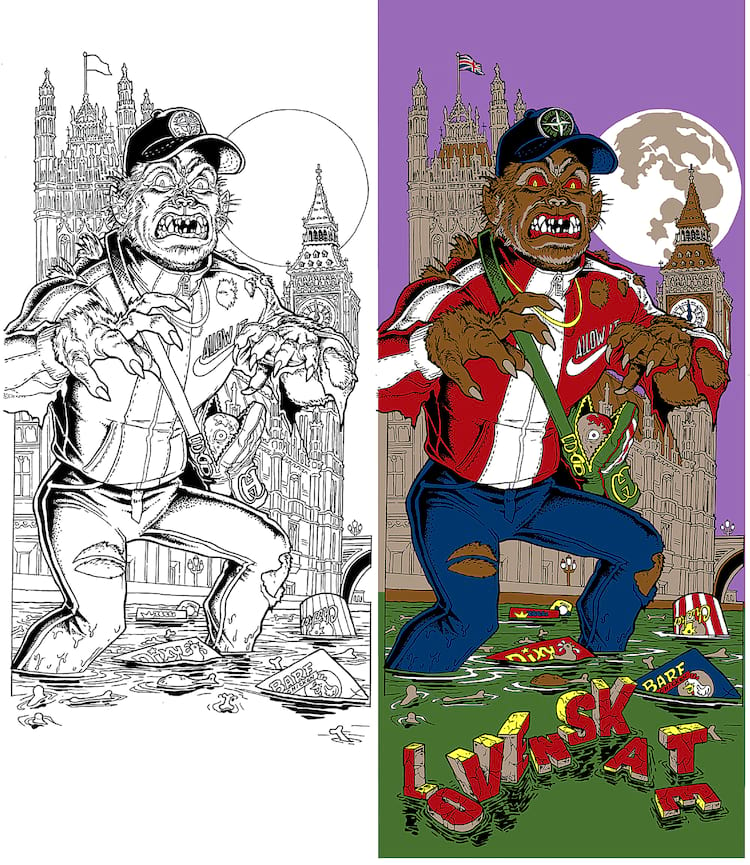
An art book this extensive means that you must have good archiving with your work. Can you describe what your file management is like, both in terms of the original art and their digital files?
My file management is probably inscrutable to outside eyes but it does make sense to me. Files are generally organized into the different companies and individuals I’ve collaborated with, and then subdivided into individual projects. I always save a high-resolution version of things, even many process scans, for exactly this type of book. That made it easy to go back and pull these images where applicable to page spreads that show different stages of the art. It helps to regularly update a master hard drive with all files and store it separately from your other equipment. I also had help photographing my board collection from my friend and skate compatriot Ben Steck. He’s a state library archivist and his help was invaluable. Photographing the boards took some pressure off the need to go through 15 years of files. Many of the process shots were also photographs of the actual artwork. All drawings—20 years worth—are stored in flat files and archival books, so it was just a matter of digging through the piles and finding the gold.
What advice would you give to someone considering self publishing?
It’s more of a warning than it is advice, but the thing to prepare for is that creating the book is only half of the job. Writing, designing and laying out a book is a ton of work, but when it comes back from the printer you’ve still only just begun. When the luster of those new books loses its glow, you’ve still got to keep telling people they exist, sitting behind tables at events and receiving and packing orders. Those are all the parts that can be helped by partnering with a publisher, but if you chose to be a one-man band, then that’s the leg work you get saddled with. It’s time consuming, so be prepared for it.
If you had to pick one favorite board graphic that you’ve done, what would it be?
Lately I’d have to say it’s the “Shed Head” graphic—it’s a Hitz/Shed deck that depicts a bloody, split-open head with the perpetrating axe-wielding maniac in the background. In a lot of ways it feels like the most visually successful, in that it’s very identifiable at a distant glance and still interesting upon closer inspection. But what sets it over the top for me is the photo by Jonathan Mehring of Josh Viles doing a backside air on this gory board in the deep end of the Lost Bowl. The two of them working on a photo shoot together with one of my boards was an inspiring experience. This became the title page spread of Barf Skate and really drove me to push this book to the next level. Even though you asked me to pick just one, I have to say a second favorite is the “Shredator” graphic collaboration with Koloss skateboards from Germany and the Austrian thrash band Insanity Alert. It was an idea I came up with which the band ended up writing a song about. It’s full gnar.
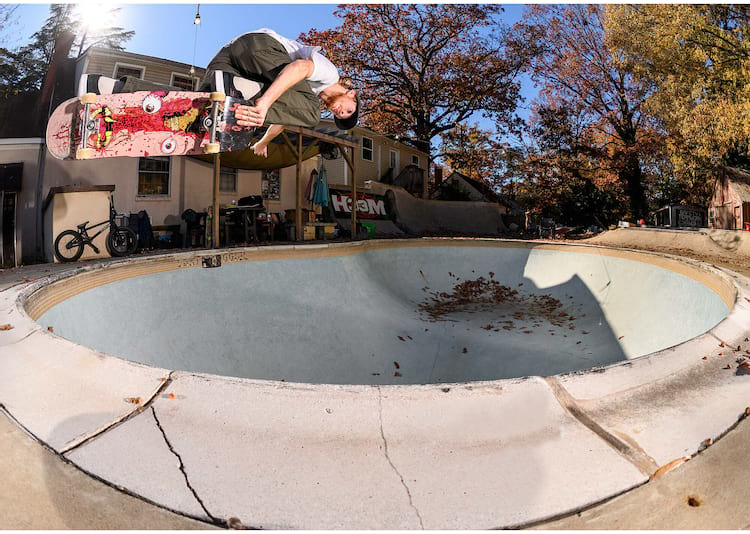 Josh Viles / Photo: Mehring
Josh Viles / Photo: Mehring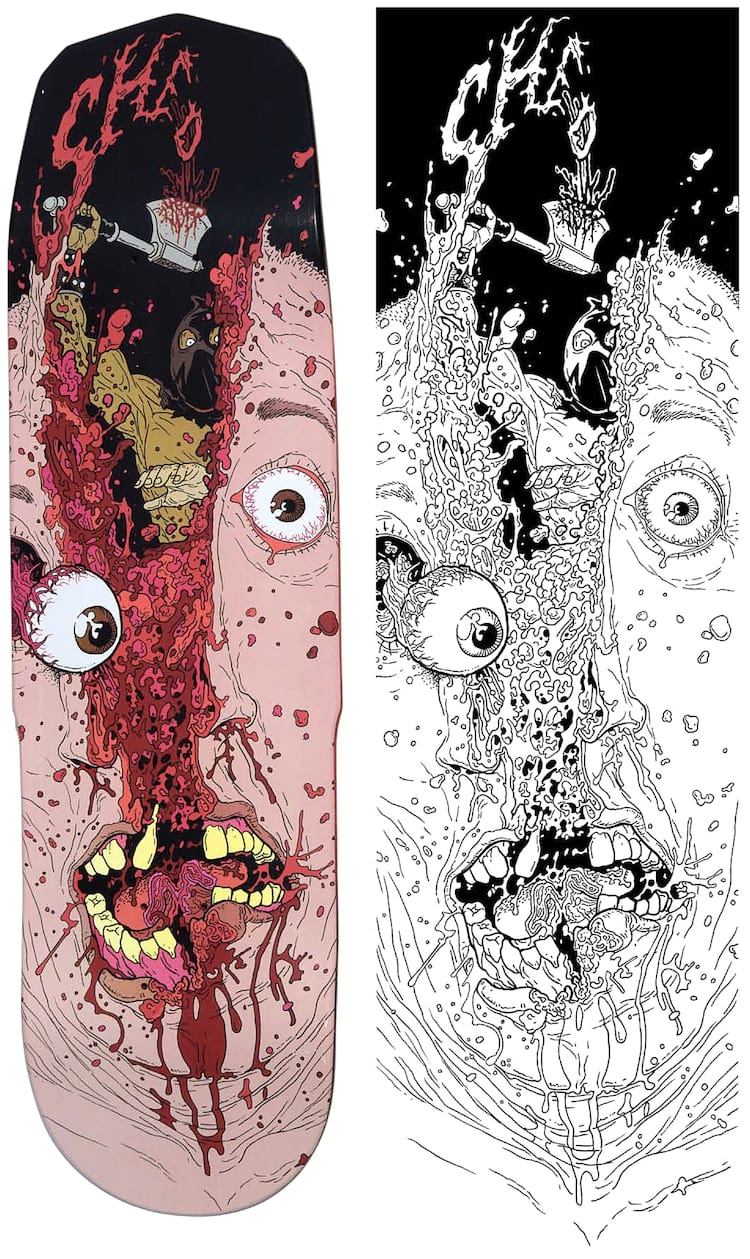
Not to play favorites, but some of those Lovenskate graphics seem to be among your best. Describe your relationship with those guys.
Thanks. Lovenskate is amazing and everything I’ve gotten to do with them has been a privilege. They’re a London-based company founded and run by Stu Smith. They screen print all of their graphics by hand, something very few companies still do, and are consummate crafts people. Everything they make has a tangible feeling of fun and they’re not afraid to experiment on weird ideas. It’s a crazy thing to work with people who live an ocean away but you vibe with so well that it’s as if you working with people in your own local crew. On top of all that, some true legends make up their roster of rippers—Alex Hallford, Jordan Thackeray, Lucy Adams and Ewen Bower for example.
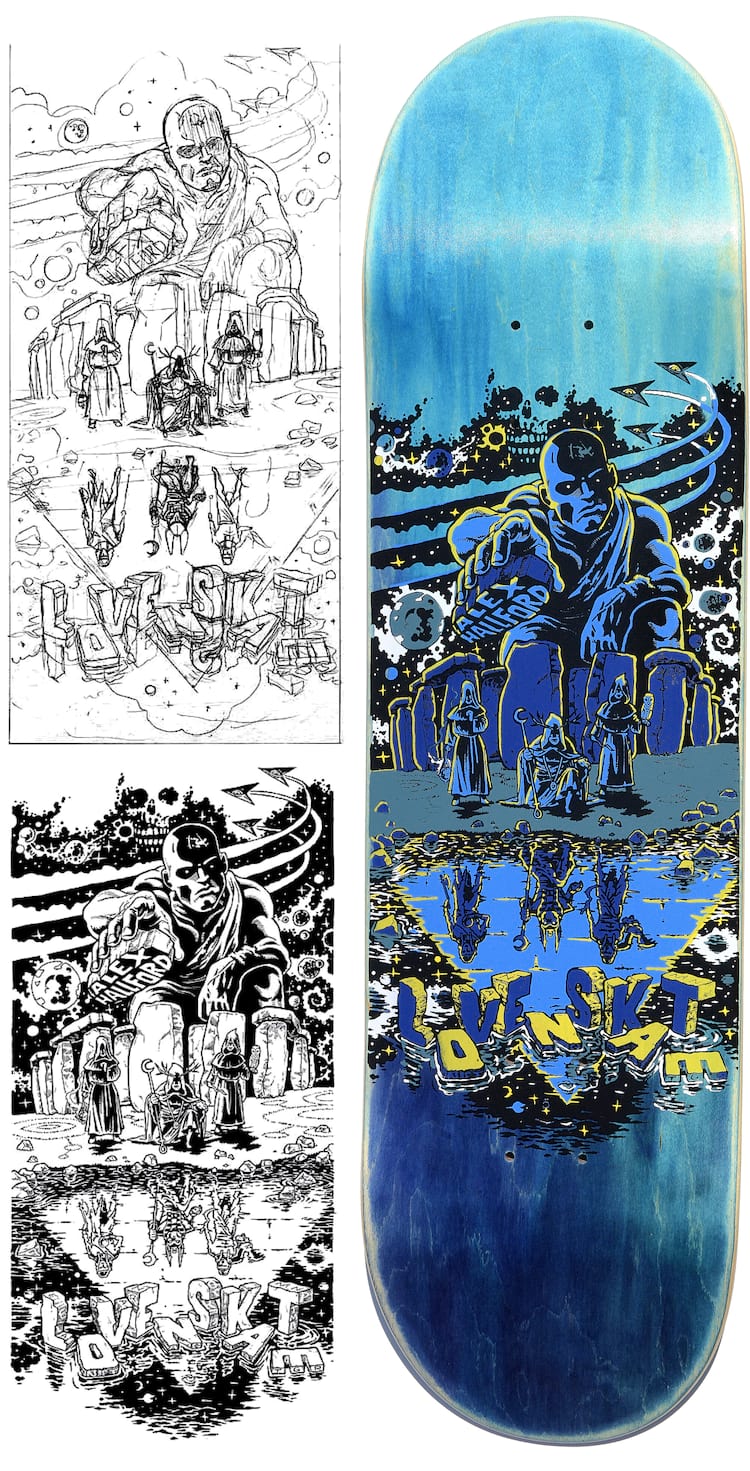
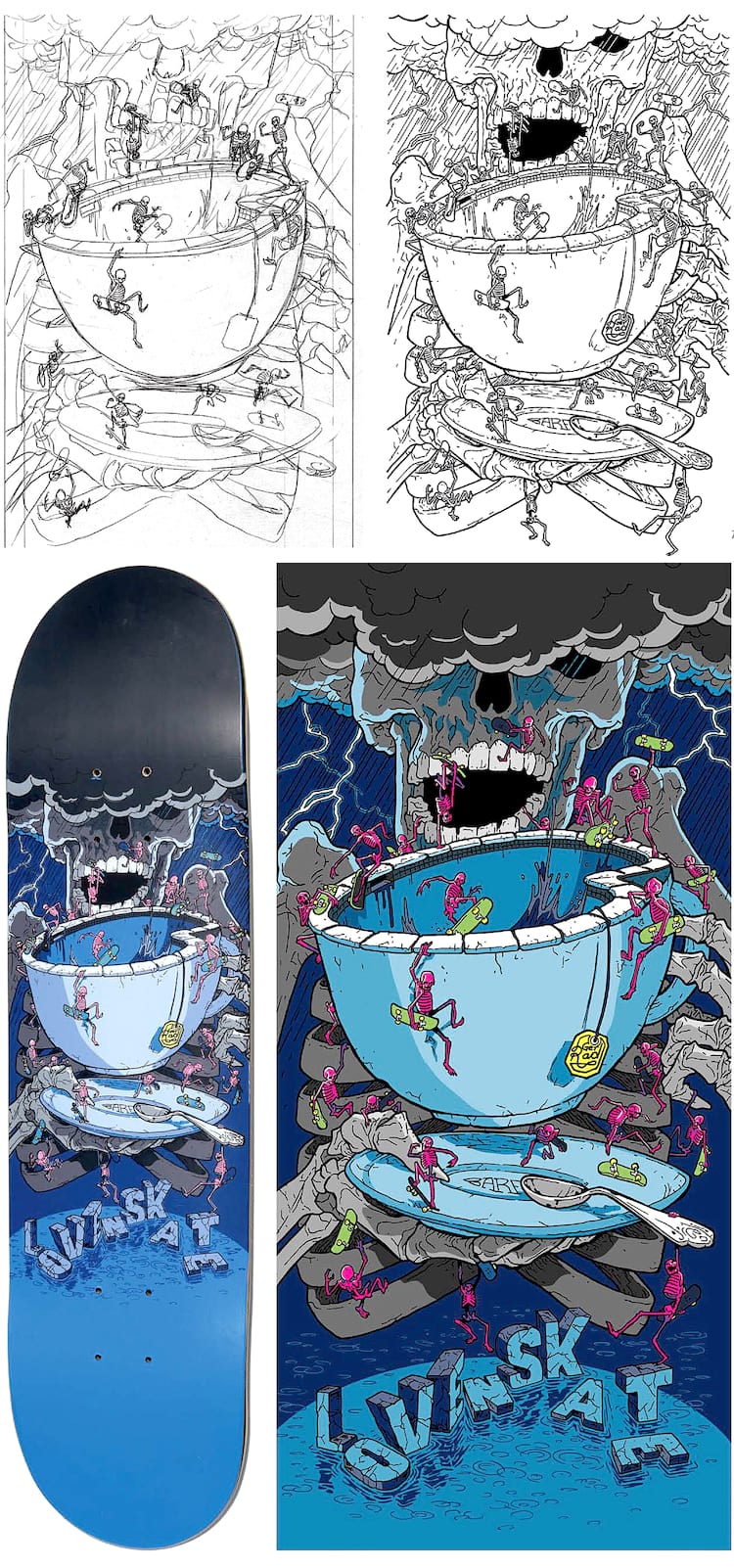
The Creature/Hitz pinball graphic also deserves special mention. What are your memories of that project?
It’s another example of Hitz and myself being on the same broken-brain wavelength. A few projects I had worked on had lead my interests towards pinball and back-glass art because of its heavy line weight and bold colors. At a moment when I was digging into the decades of history within the genre, I got a call from Hitz with a loony idea—he had been playing a bunch of pinball in local dives and decided we had to make a “Larb Ball” pinball deck. Naturally, I was down. When a project comes along that lines up with my current obsessions, things can get out of hand. For no reason at all, I decided that if I was designing a fake pinball machine, it would have to be as close to functional as if it were being built as a real life machine. I studied play fields and tried to get as close to working machine as possible. Between the main graphic and the top graphic, I was able to show enough sides of the cabinet to design the entire machine exterior. The crossover of skate fans and pinball enthusiasts bought up the entire run in days. I’ve been working with a friend on making a re-theme of an existing machine. Stay tuned!
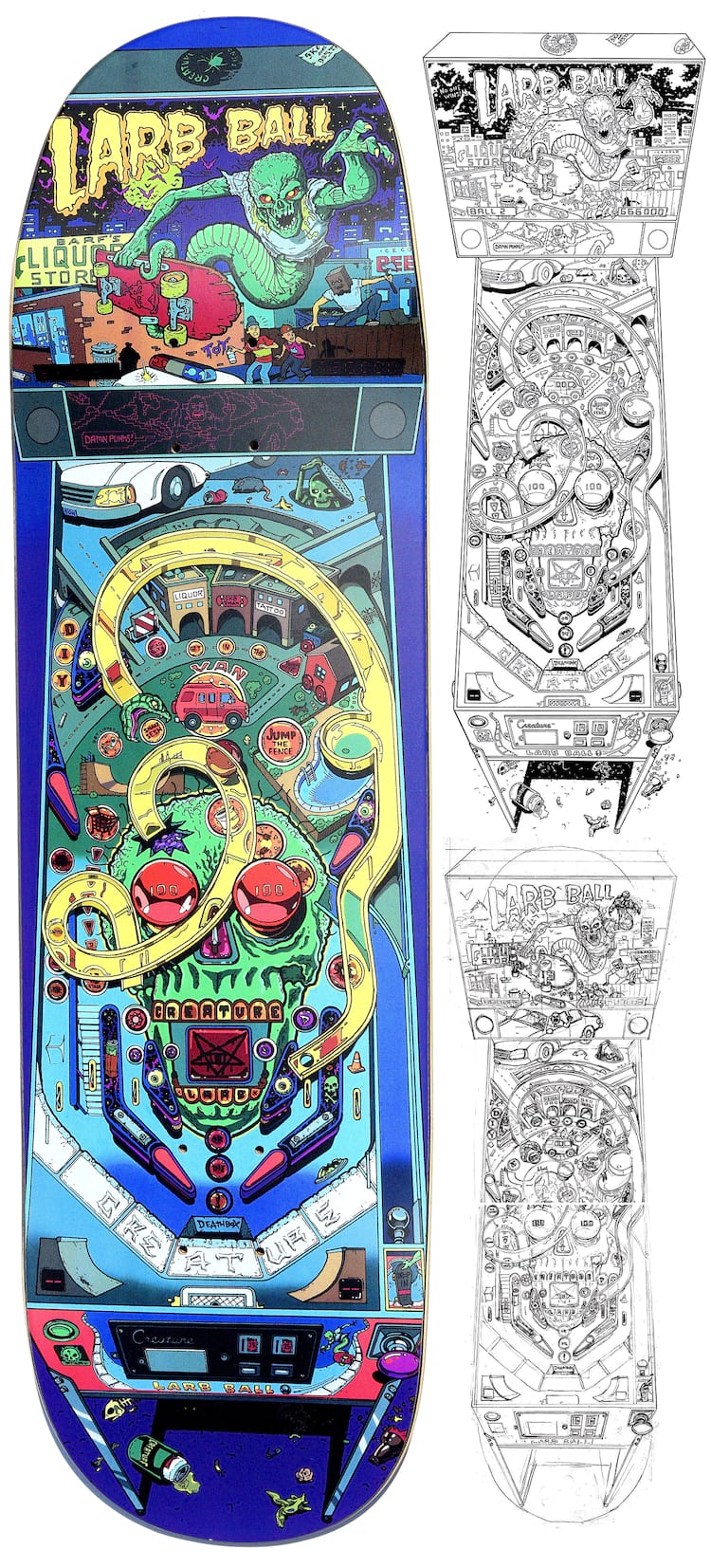
You have an amazing 12-plus year legacy of Thrasher contributions. What have been some of your favorite projects?
In issue 500 we did an article on skate punk bands, specifically how to make your own. Hilariously written by Sam Hitz, it already had the foundation of a good piece, but I had a small window to get the art done. This was one of those rare instances where that tight deadline forced a bizarre creativity that avoided specifics for a better result and we wound up with an odd batch of toxic mutants shredding their haphazardly constructed instruments. Also, all the comic covers and Slam Demons were fun, too. I think my very first Thrasher project might take the cake, though. It was called The Journey and showed the progression of a skater, growing and slashing through life’s obstacles in search of the hidden reward behind the pursuit. It struck a chord with people and years later I still get messages from people around the globe describing how it influenced and inspired them.
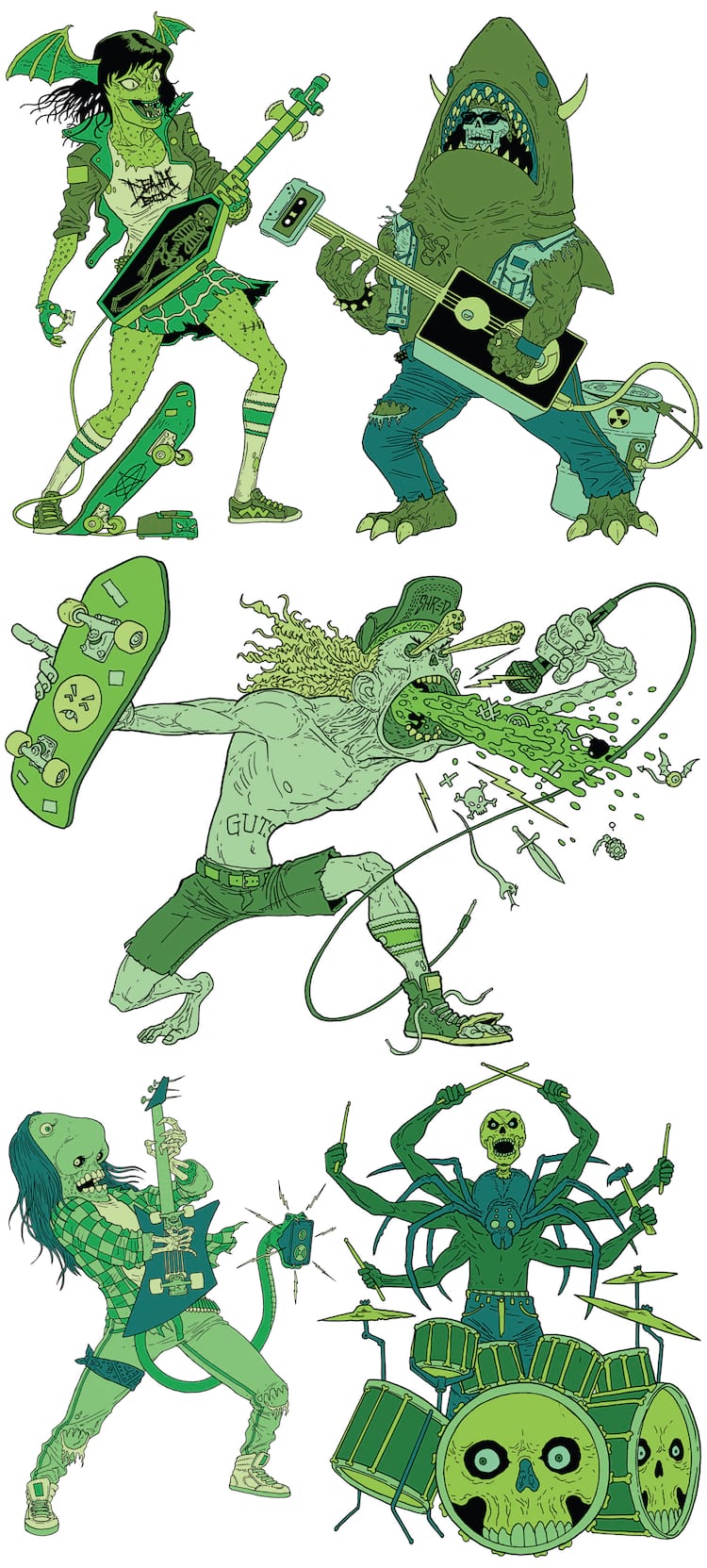
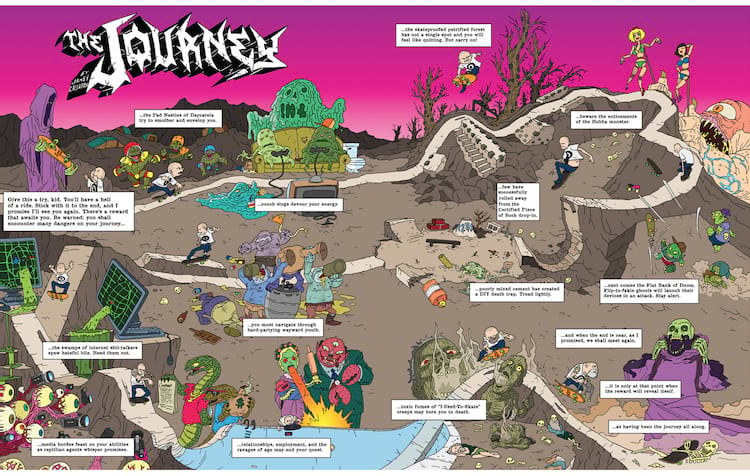
You’ve juggled hundreds of freelance gigs. How do you deal with hunting down all of those payments? Do you ever have to take fools to small claims court?
Ha! No, fortunately not. After you’ve been doing this for a while you develop an ability to sniff out the bullshitters. Bigger companies almost always pay their bills after you jump through a few hoops and wait whatever is their designated turnaround time. Smaller companies and individuals can sometimes get in over their head and realize they don’t have the money that they promised you, even if you’re making your work as affordable as possible. It’s easy to figure out who’s serious and has their ducks in a row by asking for half up front. If they’re serious and not blowing smoke, they’ll abide. Bullshitters will disappear, never to haunt your inbox again.
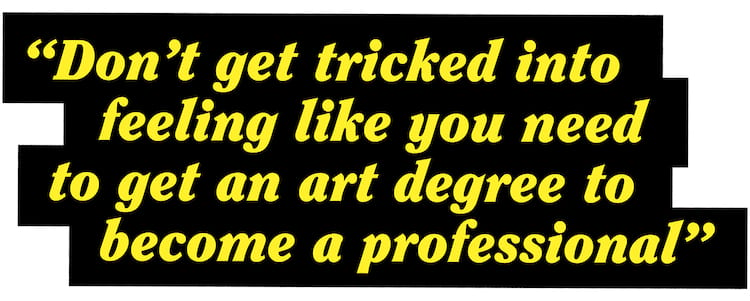
If a talented, ambitious teenage artist asked you if they should go to art school or not, what’s your advice?
It depends on what your focus is. If a degree is important to you, I’d say go to a community college first and transfer your basic academic requirements to your desired school for your upper-level classes. You’ll skip tens of thousands of dollars of debt. I found art school helpful because it was the first time that anyone gave me honest, harsh and unforgiving feedback. Before that, all I received was praise, but I could tell my work was still basic and amateur. It helped push me to the next level, although I had to still do a lot of development on my own after I graduated. People can find that type of expert feedback in other arenas, so don’t get tricked into feeling like you need to get an art degree to become a professional.
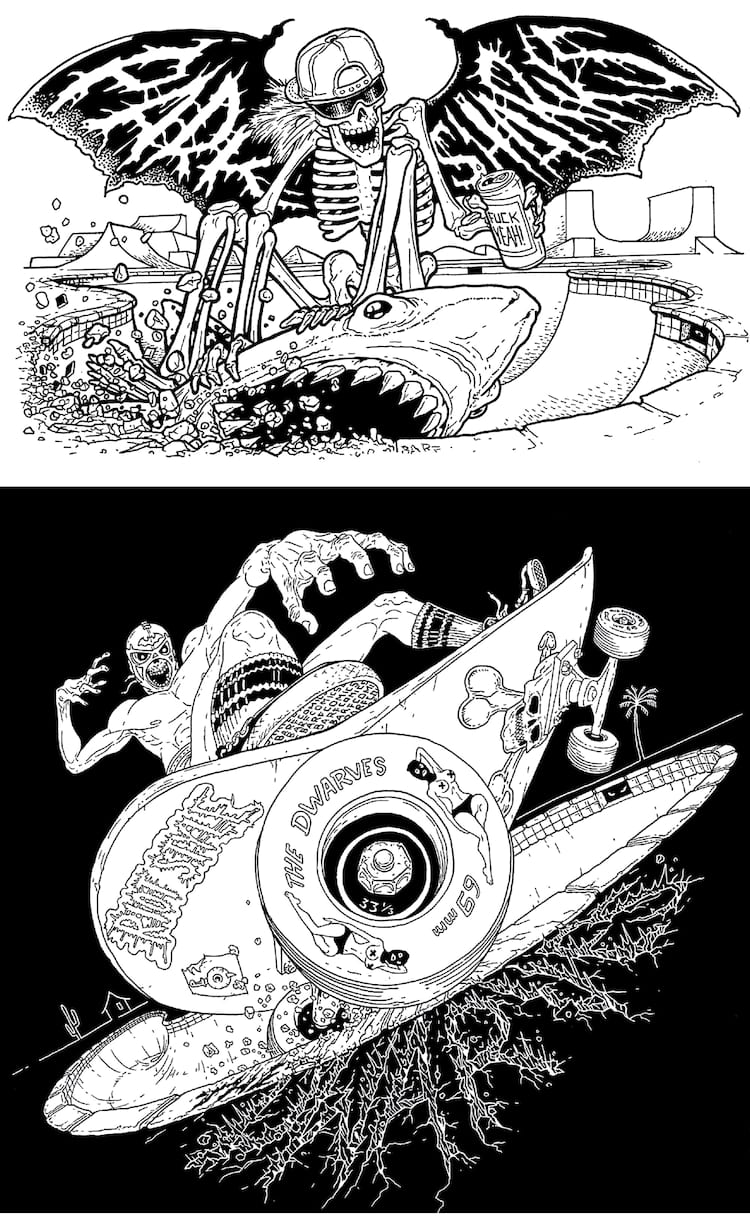
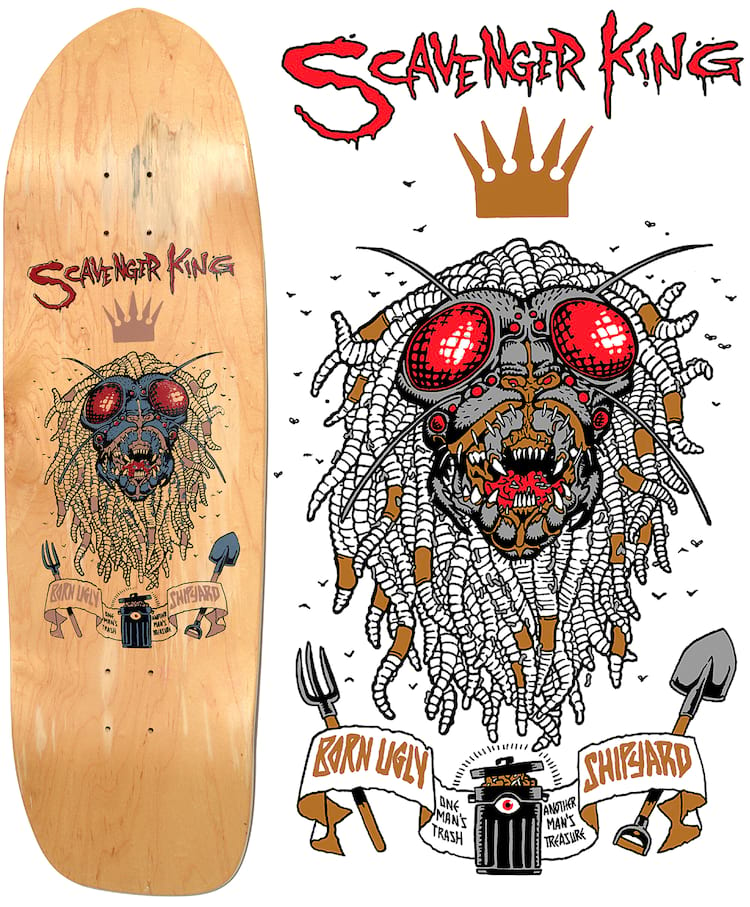
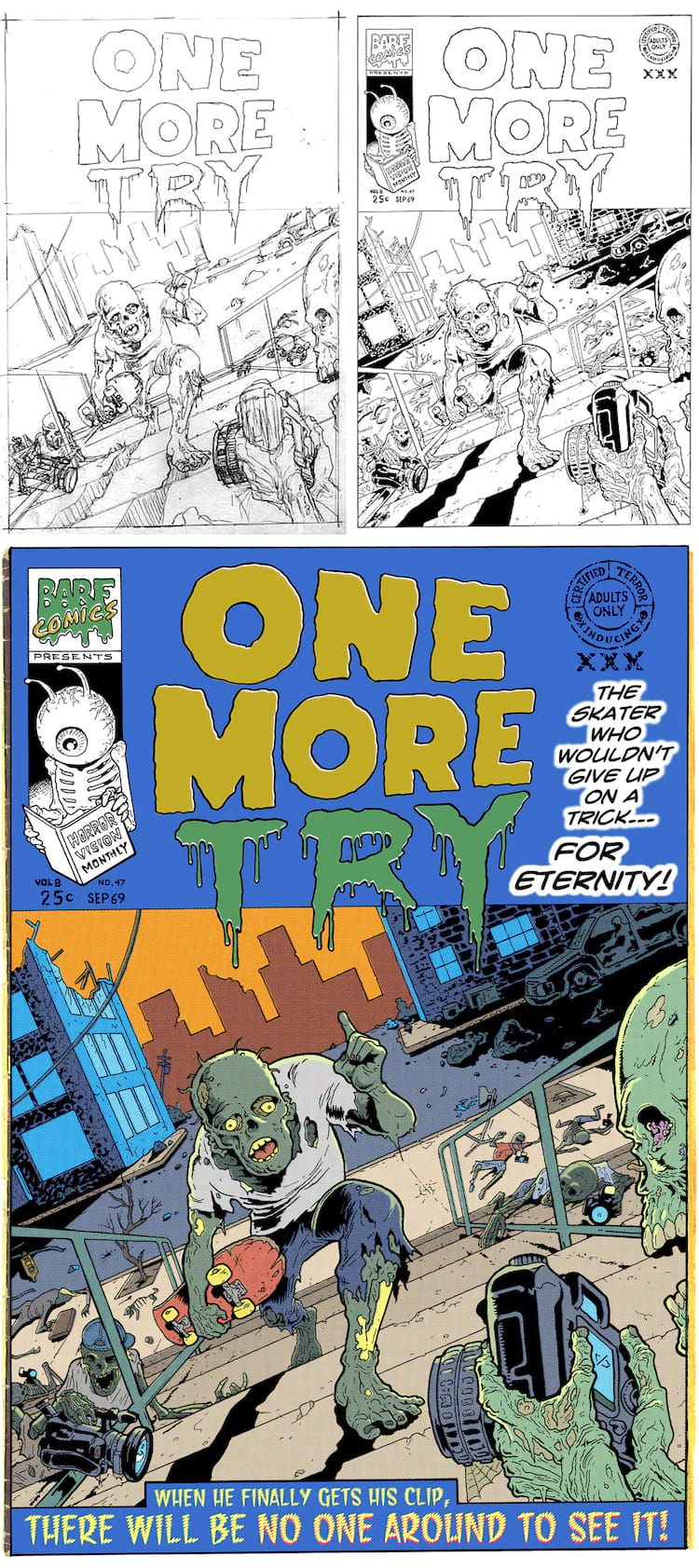
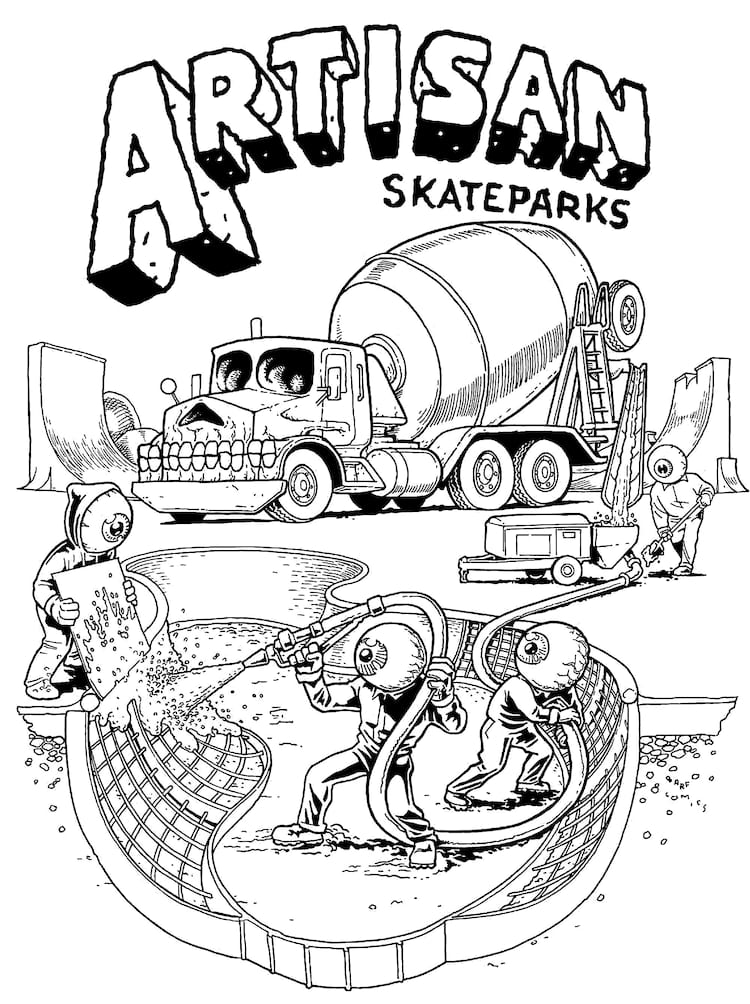
Cool. Well, thanks for being a part of the mag, James, and congrats on the book!
Thanks! As always, I’m psyched to be involved with Thrasher. You all have the most dedicated readers in the world.
For more info on James and his book "Barf Skate," visit here.
-
2/14/2025
Thrasher Valentine's Day Cards 2025
These Valentine's Day cards contain love, romance, and mediocre Photoshop skills! The cards do NOT contain any advance notice or permission from the skaters featured. -
2/14/2024
Thrasher Valentine's Day Cards 2024
When it comes to Valentine's Day, are you cynical? Jaded? Pessimistic? Then don't click here! These V-Day cards are for true lovers only. -
12/24/2023
SOTY Party 2023 Photos
Once the decision is made, the only thing left is one big ol’ bash in The City to cap the year off right. Karl Watson came through for the official handoff along with a host of A-listers from Primitive, adidas and our home turf. Couldn’t get in the door? Catch it all here. -
2/14/2023
Thrasher Valentine's Day Cards 2023
If you don't have a gift for Valentine's Day, you can always send your loved one (or your sworn enemy) one of these shoddy Photoshop cards. -
3/31/2022
Canvas Artist Profile: Thomas Fernandez
Monsters, comic books, and skate culture collide in the artistic offerings of Thomas Fernandez. Take a look at the unique, colorful creations that pour from his twisted mind.



